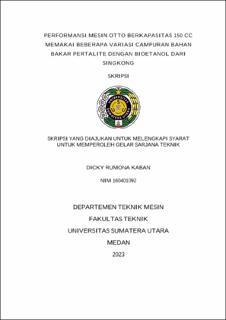| dc.description.abstract | This study is aimed at gaining insights into the influence of blended fuels of Pertalite and Bioethanol on the optimal performance of the Otto engine and understanding the level of exhaust gas emissions from each type of fuel used. The engine to be tested is a single-cylinder 150 cc Otto engine, Honda CRF 150L model year 2018, using variations of Pertalite, Pertalite E10, Pertalite E15, and Pertalite E20 fuels. To understand the engine performance, testing is conducted using a dynotest machine, while exhaust gas emission testing is carried out using a Gas Analyzer Suk Young 401 device through exhaust gas emission sensors installed on the Honda CRF 150L motorcycle's exhaust. Parameters for the Otto engine performance values are torque, power, and air-fuel ratio. The results show that the average high heating value (HHV) of the fuels is 48823.6 kJ/kg (Pertalite), 42941.1 kJ/kg (Pertalite E10), 47491.2 kJ/kg (Pertalite E15), and 43676.5 kJ/kg (Pertalite E20). The highest torque is obtained in the dynotest with a value of 14.6 Nm at an engine speed of 5000 rpm using Pertalite E20 fuel. The highest power is obtained in the dynotest, which is 9.5 kW at an engine speed of 7000 rpm using Pertalite E20 fuel. The maximum air-fuel ratio obtained in this test is 19.709 using Pertalite E15 at 3000 rpm. For CO levels, the highest value is found in Pertalite E20, reaching 988 PPM. For H2S levels, the highest value is found in Pertalite E10, reaching 10 PPM. For EX levels, the highest value is found in Pertalite E10, reaching 7%LEL. For O2 levels, the highest values are found in Pertalite E10 and Pertalite E15, reaching 20.1%VOL. | en_US |


